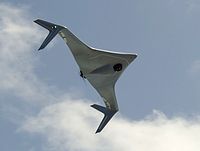
Photo from wikipedia
Reduced drag, increased lift and, consequently, increased vital ratio and lift-to-drag coefficients are crucial in almost all efficient micro air vehicles. Riblet geometries use a variety of air vehicles. Further… Click to show full abstract
Reduced drag, increased lift and, consequently, increased vital ratio and lift-to-drag coefficients are crucial in almost all efficient micro air vehicles. Riblet geometries use a variety of air vehicles. Further investigation on micro air vehicles is, however, necessary for enhanced development. Rectangular riblets on a rectangular micro air vehicle are computationally investigated. In this study, the governing equation of fluid flow is solved numerically; the turbulent model around the NACA S5020 airfoil section is covered by riblets either on both sides or on the upper side of the wings. Results show a difference of behavior in drag reduction due to the angle of attack on the airfoil. When the lift-to-drag coefficient of an angle of attack is at its maximum, an improvement can be observed, where lift-to-drag ratio increases, and drag decreases. Results for the two-side riblets show an increase in the lift-to-drag ratio as well; although the lift-to-drag coefficient and the drag reduction of riblets on both sides were comparatively less than that for riblets on the upside.
Journal Title: Proceedings of the Institution of Mechanical Engineers, Part G: Journal of Aerospace Engineering
Year Published: 2017
Link to full text (if available)
Share on Social Media: Sign Up to like & get
recommendations!